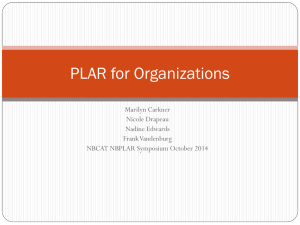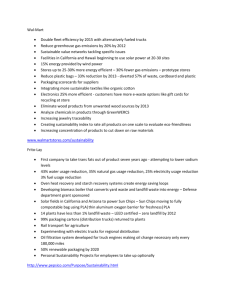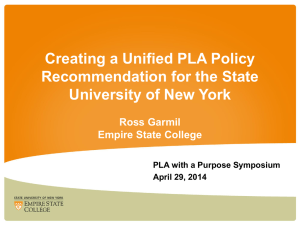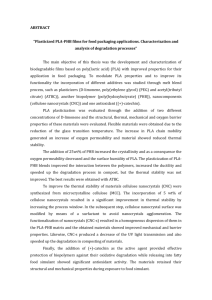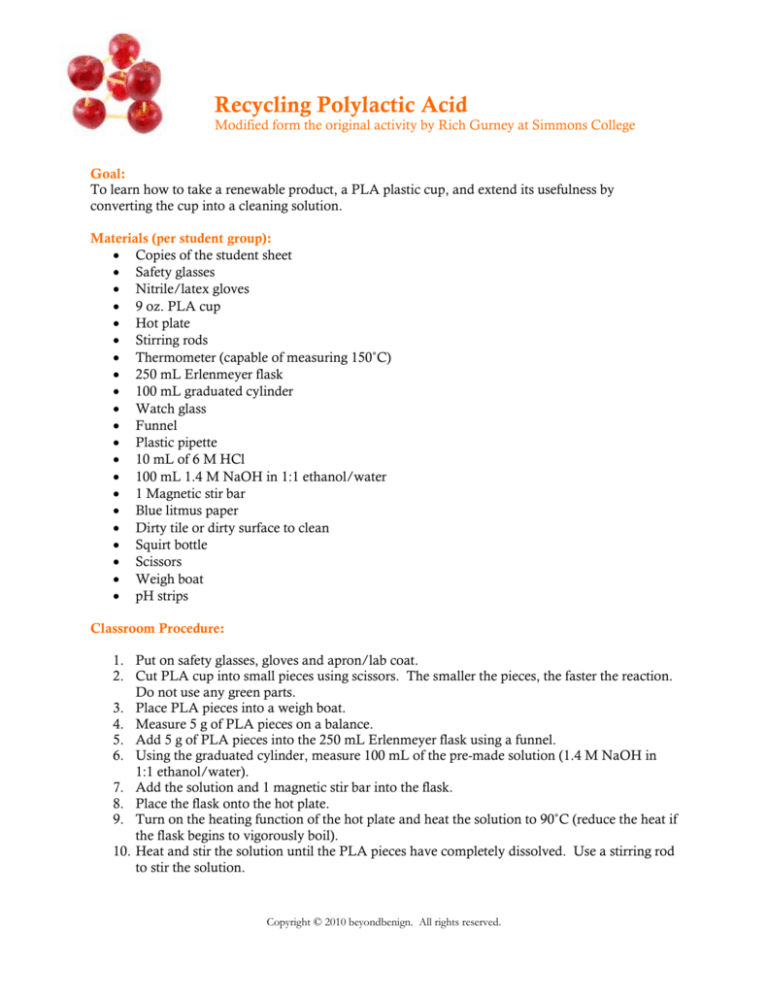
Recycling Polylactic Acid
Modified form the original activity by Rich Gurney at Simmons College
Goal:
To learn how to take a renewable product, a PLA plastic cup, and extend its usefulness by
converting the cup into a cleaning solution.
Materials (per student group):
Copies of the student sheet
Safety glasses
Nitrile/latex gloves
9 oz. PLA cup
Hot plate
Stirring rods
Thermometer (capable of measuring 150˚C)
250 mL Erlenmeyer flask
100 mL graduated cylinder
Watch glass
Funnel
Plastic pipette
10 mL of 6 M HCl
100 mL 1.4 M NaOH in 1:1 ethanol/water
1 Magnetic stir bar
Blue litmus paper
Dirty tile or dirty surface to clean
Squirt bottle
Scissors
Weigh boat
pH strips
Classroom Procedure:
1. Put on safety glasses, gloves and apron/lab coat.
2. Cut PLA cup into small pieces using scissors. The smaller the pieces, the faster the reaction.
Do not use any green parts.
3. Place PLA pieces into a weigh boat.
4. Measure 5 g of PLA pieces on a balance.
5. Add 5 g of PLA pieces into the 250 mL Erlenmeyer flask using a funnel.
6. Using the graduated cylinder, measure 100 mL of the pre-made solution (1.4 M NaOH in
1:1 ethanol/water).
7. Add the solution and 1 magnetic stir bar into the flask.
8. Place the flask onto the hot plate.
9. Turn on the heating function of the hot plate and heat the solution to 90˚C (reduce the heat if
the flask begins to vigorously boil).
10. Heat and stir the solution until the PLA pieces have completely dissolved. Use a stirring rod
to stir the solution.
Copyright © 2010 beyondbenign. All rights reserved.
11. After the PLA pieces have completely dissolved and the solution is pale yellow, turn off the
hot plate. Temperature should be 80˚C – 90˚C.
12. Use heat resistant gloves to remove flask from hot plate. Place the flask in an ice water bath
and allow the solution to cool until it is below 60˚C. This mixture is now called “hydrolyzed
PLA”.
13. Using the plastic pipette, transfer 1-2 drops of the solution to the watch glass.
14. Test the pH of the hydrolyzed PLA by wetting a pH strip in the watch glass. Record the pH.
15. Slowly add 50 drops of 6 M HCl into the flask. Mix well.
16. Dip the glass stirring rod into the solution then touch it to the mouth of the flask to remove
big drops of liquid. The wetted tip can then be touched to a strip of blue litmus paper to test
its pH. Note whether the solution is acidic or basic.
17. Record whether the solution is acidic or basic after each test (thoroughly mix the solution
after adding 6 M HCl before testing it).
18. Repeat steps 15-17 until an acidic pH is obtained. Each strip of litmus paper can be used
several times.
19. Measure the final pH of the solution using a pH strip. Aim for a pH range of 4-5. The
solution now contains lactic acid and sodium chloride (NaCl).
20. Using a funnel, transfer the lactic acid solution into the squirt bottle.
21. Spray the solution onto a dirty surface and wipe clean with a paper towel.
Copyright © 2010 beyondbenign. All rights reserved.
Recycling Polylactic Acid
Data Sheet:
Name:
Date:
Plastic Type:
Draw the plastic resin
code symbol:
Set temperature to:
°C
Mass of plastic used:
grams
Set stir rate to:
rpm
Solvent used:
Appearance of plastic before it is placed in solution:
Appearance of solution before reaction starts: (color, transparency, presence of particulates?)
Record temperature and observations at 2 minute intervals
#
Time
minutes
Temperature (°C)
Observation
0
2
4
6
8
10
Appearance of plastic after it is placed in solution:
Copyright © 2010 beyondbenign. All rights reserved.
Appearance of solution after reaction stops: (color, transparency, presence of particulates?)
Does this plastic degrade under base hydrolysis conditions?
What is the pH of the solution after the reaction stops and BEFORE any HCl is added?
Fill in the following data table after each 50 drop addition of 6 M HCl
What color is your litmus paper (dry)?
# drops
6 M HCl
Color of litmus paper
after addition
pH
Acid or Base?
Did the resulting solution effectively clean a dirty surface?
Copyright © 2010 beyondbenign. All rights reserved.
Teacher Background Information:
The world produces approximately 200 billion pounds of plastics and nearly half of this plastic
winds up in landfills each year. Polyethylene (HDPE/LDPE), polyethylene terephthalate (PET),
and polystyrene (PS) are common polymers that constitute plastics, but they have enormous
degradation lifetimes. These polymers can persist in the environment for 500 to 1000 years without
biodegrading; current composting enzymes and bacteria are unable to break them down any faster.
Because plastics (polymers) have degradation periods significantly longer than their useful lives, they
persist in landfills for enormous periods of time. Additionally, traditional plastics are produced from
petroleum, which is a nonrenewable resource. Taking into account the complete life cycle of plastics
is crucial to why there is a need for alternatives. Plastics are woven into the fabric of US society and
examining alternatives to current manufacturing practices is a burgeoning area for green chemists.
Polylactic acid (PLA) is a biodegradable polymer derived from natural resources. Lactic acid, which
is derived from corn, is the monomer used to create this polymer. PLA degrades under compost
conditions into CO2, H2O, and humus, all benign components. PLA will generally breakdown under
industrial compostable conditions in approximately 180 days. Because it biodegrades, the volume
sent to the landfill can be reduced significantly. Also, the CO2 released during degradation returns
the carbon to the atmosphere with no overall net gain. Since the polymer is made from a corn
feedstock, the process uses significantly less petroleum than traditional polymers. It is categorized
under plastic resin code #7 or #0 (“other plastics”). While it is recyclable, currently there are no
municipal recycling facilities that accept PLA.
Instead of disposing PLA products into landfills or compost facilities, another option of handling
them at the end of the products’ useful life is to reuse them as other products. One thing to do with
PLA materials is to convert them into an antimicrobial cleaning solution.
This lab has been adapted from “Hydrolysis of post-consumer polylactic acid waste”. Gurney, R.
Dept. of Chemistry. Simmons College. 2008.
http://greenchem.uoregon.edu/PDFs/GEMsID102.pdf
Current work is being done at Beyond Benign to use a less concentrated base and acid in order to
achieve full hydrolysis of the PLA. As we develop improvments to the lesson we will post the
changes on the web.
For more information about Polymers and PLA check out the following sites:
http://pslc.ws/macrog/index.htm Site is devoted to polymer basics
www.greenplastics.com Site is dedicated to bio-based plastics
Educational Goal: To understand how PLA is an example of green chemistry technology.
Student Objectives: Students will …
Learn about renewable “corn” plastic made from polylactic acid
Recycle the polylactic acid cup into a new product: a cleaning solution
Analyze PLA against the 12 principles of green chemistry
Copyright © 2010 beyondbenign. All rights reserved.
Materials:
Copies of the student sheet
Safety goggles
Nitrile/latex gloves
500 mL ethanol
500 mL distilled water
56 g NaOH (sodium hydroxide) pellets
50 mL 12 M HCl
50 mL distilled water
1000 mL Erlenmeyer flask
125 mL Erlenmeyer flask
500 mL graduated cylinder
50 mL graduated cylinder
2 magnetic stir bars
Stirring hot plate
Label tape
Permanent marker
Weigh boat
Time Required: 2 x 60 minutes class periods
National Science Standards Met: S3, S6, S7
MA Standards Met: SIS1, SIS2, C1, C5, C8
Green Chemistry Principles Addressed: 1, 7, 9, 10
Procedure:
Day 1:
PREP (if needed)
Prepare copies of student sheets
Locate dirty surface for students to test their cleaning solutions on (surfaces with soap scum
such as dirty classroom sinks work well)
Prepare 1000 mL 1.4 M NaoH in 50% ethanol in water solution
Measure 56 grams NaOH on a scale
Transfer NaOH to 1000 mL Erlenmeyer flask
Measure 500 mL distilled water in 500 mL graduated cylinder
Transfer 500 mL distilled water and a magnetic stir bar to beaker
Dissolve 56 grams of NaOH in water by stirring the solution using a magnetic stirrer
and the stirring hot plate
Measure 500 mL ethanol in 500 mL graduated cylinder
Slowly add 500 mL ethanol to beaker of water
Allow to mix thoroughly by stirring
Label solution “1.4 M NaOH in 50% ethanol in water solution” with label tape and
permanent marker
Warning: Concentrated base can cause burns. As you are weighing out the sodium
hydroxide (NaOH), wear the proper protective equipment (gloves, goggles, lab coat
Copyright © 2010 beyondbenign. All rights reserved.
or apron). If the NaOH touches skin, wash immediately with copious amounts of
water.
Prepare 100 mL 6 M HCl
Measure 50 mL distilled water in 50 mL graduated cylinder
Transfer water to 100 mL 125 mL Erlenmeyer flask
Add a new magnetic stir bar to the Erlenmeyer flask and stir the solution using the
stirring hot plate
Measure 50 mL 12 M HCl in 50 mL graduated cylinder
Slowly add the HCl to beaker of water
Allow to mix thoroughly
Dispense the 100 mL of solution (6 M HCl) into 10 drop-dispensing bottles
Label bottles “6 M HCl”. Each bottle should contain 10 mL 6 M HCl.
NOTE: Always add acid to water!! This is an exothermic reaction and slowly
adding the acid to water will prevent spattering of the solution.
Warning: Concentrated acid can cause burns to skin and can pose a respiratory
hazard from the fumes. When measuring and working with the hydrochloric acid,
wear the appropriate protective equipment (gloves, goggles, lab coat or apron)
and work in a fume hood to avoid inhalation exposure of the hydrochloric acid
fumes.
Use the Power Point Presentation to review PLA and Plastics
Hand out the article “Corn Plastic to the Rescue”. Have students read the article or read it
as a class. (You may also want to assign this article as homework reading prior to class)
Discuss the article and ask the students what they think about PLA
Challenge the students to use the least amount of litmus paper during the lab experiment.
Reward the group that uses the fewest strips.
Day 2:
Set up student stations
Each station should have the following set up before the students begin:
1 x hot plate
1 x 250 mL Erlenmeyer flask
1 x small watch glass
1 x stirring rod
1 x paper towel
1 x plastic squirt bottle
1 x drop-dispensing bottle containing 10 mL 6 M HCl
100 mL 1.4 M NaOH in 50% ethanol in water solution
4 x blue litmus paper
2 x pH strips
1 x plastic or glass funnel
1 x 9 oz. PLA cup
2 x pairs of scissors
1 x weigh boat
Pass out several plastic cups and PLA cups around the room
Ask the students to examine them and list the differences
Proceed with the lab (Demo steps if necessary)
Copyright © 2010 beyondbenign. All rights reserved.
Background Reading
Corn Plastic to the Rescue
Wal-Mart and others are going green with "biodegradable" packaging made from corn. But is
this really the answer to America's throwaway culture? Royte, Elizabeth. Smithsonian magazine,
August 2006.
Thirty minutes north of Omaha, outside Blair, Nebraska, the aroma of steaming corn—damp and
sweet—falls upon my car like a heavy curtain. The farmland rolls on, and the source of the smell
remains a mystery until an enormous, steam-belching, gleaming-white architecture of tanks and
pipes rises suddenly from the cornfields between Route 75 and the flood plain of the Missouri River.
Behold NatureWorks: the largest lactic-acid plant in the world. Into one end of the complex goes
corn; out the other come white pellets, an industrial resin poised to become—if you can believe all
the hype—the future of plastic in a post-petroleum world.
The resin, known as polylactic acid (PLA), will be formed into containers and packaging for food
and consumer goods. The trendy plastic has several things going for it. It’s made from a renewable
resource, which means it has a big leg up—both politically and environmentally—on conventional
plastic packaging, which uses an estimated 200,000 barrels of oil a day in the United States. Also,
PLA is in principle compostable, meaning that it will break down under certain conditions into
harmless natural compounds. That could take pressure off the nation’s mounting landfills, since
plastics already take up 25 percent of dumps by volume. And corn-based plastics are starting to look
cheap, now that oil prices are so high.
For a few years, natural foods purveyors such as Newman’s Own Organics and Wild Oats have
been quietly using some PLA products, but the material got its biggest boost when Wal-Mart, the
world’s largest retailer, announced this past October that it would sell some produce in PLA
containers. The move is part of the company’s effort to counter criticisms that it has been
environmentally irresponsible. “Moving toward zero waste is one of our three big corporate goals for
the environment,” says Matt Kistler, vice president of private brands and product development for
the retailer. Wal-Mart plans to use 114 million PLA containers a year, which company executives
estimate will save 800,000 barrels of oil annually.
To make plastic packaging and containers from a renewable resource that can be returned to the
earth as fertilizer sounds like an unmitigated good. Selling fruits and veggies in boxes that don’t
leach chemicals into landfills sounds equally wonderful. But PLA has considerable drawbacks that
haven’t been publicized, while some claims for its environmental virtues are downright misleading.
It turns out there’s no free lunch after all, regardless of what its container is made of, as I learned
when I tried to get to the bottom of this marvelous news out of corn country.
Copyright © 2010 beyondbenign. All rights reserved.
At the NatureWorks plant in Blair, I don a hard hat, earplugs, gloves and protective eyewear and
swear that I will snap no photographs. What can be revealed by my hosts is revealed: corn kernels
are delivered and milled, dextrose is extracted from starch. Huge fermenters convert the dextrose
into lactic acid, a simple organic chemical that is a by-product of fermentation (or respiration, in the
case of the lactic acid that builds up in muscle tissue after intense activity). Industrial lactic acid is
derived from many starchy sources, including wheat, beets and potatoes, but NatureWorks is owned
by Cargill, the world’s largest corn merchant, and so its lactic acid comes from corn. The compound
is converted to lactide, and lactide molecules are linked into long chains or polymers: polylactic acid,
PLA.
I did get a chance to see and touch the obscure object of my desire when some liquid PLA, with the
color and shine of caramelized sugar, burst from a pipe and solidified in flossy strands on the steelgrated floor. The next time I saw the stuff, in a box in a warehouse, it had been crystallized into
translucent white balls the size of peas: PLA resin. In the hands of fabricators, the pellets would be
melted and reshaped into containers, films and fibers.
Though the polymer, because of its low melting point, doesn’t yet have as many applications as does
the far more common plastic polyethylene terephthalate (PET), used to make soda bottles and some
polyester fibers, the company has plans, as a large banner in the office proclaims, to “Beat PET!” In
some ways, corn plastic is clearly easier on the environment. Producing PLA uses 65 percent less
energy than producing conventional plastics, according to an independent analysis commissioned by
NatureWorks. It also generates 68 percent fewer greenhouse gases, and contains no toxins. “It has a
drastically different safety profile,” says NatureWorks operations manager Carey Buckles. “It’s not
going to blow up the community.”
For retailers, PLA has a halo effect. Wild Oats was an early adopter of the stuff. “Our employees
loved the environmental message of the containers, that they came from a renewable resource, and
our customers had a strong reaction when we told them they were compostable,” says Sonja Tuitele,
a Wild Oats spokesperson. The containers initially boosted the company’s deli sales by 17 percent,
she says, and the chain now uses six million PLA containers a year. Newman’s Own Organics uses
PLA packaging for its salad mixes. “We felt strongly that everywhere we can get out of petroleum
products, we should,” says Newman’s Own CEO Peter Meehan. “No one has ever gone to war over
corn.”
Wal-Mart, which has begun using PLA containers in some stores, has also switched packaging on
high-end electronics from PET to a sandwich of cardboard and PLA. “It has a smaller packaging
footprint, it’s completely biodegradable and it costs less,” says Kistler. What Wal-Mart says about
PLA’s biodegradable nature is true, but there’s an important catch.
Corn plastic has been around for 20 years, but the polymer was too expensive for broad commercial
applications until 1989, when Patrick Gruber, then a Cargill chemist looking for new ways to use
corn, invented a way to make the polymer more efficiently. Working with his wife, also a chemist,
he created his first prototype PLA products on his kitchen stove. In the beginning, it cost $200 to
make a pound of PLA; now it’s less than $1.
The polymer has had to get over some cultural hurdles. In the mid-1980s, another bio-based plastic
appeared on grocery store shelves: bags made from polyethylene and cornstarch that were said to be
biodegradable. “People thought they would disappear quickly,” recalls Steven Mojo, executive
director of the Biodegradable Products Institute. They didn’t. Will Brinton, president of Woods End,
a compost research laboratory in Mt. Vernon, Maine, says the bags broke into small fragments of
polyethylene, fragments that weren’t good for compost—or public relations. “It was a big step
Copyright © 2010 beyondbenign. All rights reserved.
backward for the biodegradability movement,” he adds. “Whole communities abandoned the
concept of biodegradable bags as a fraud.”
According to a biodegradability standard that Mojo helped develop, PLA is said to decompose into
carbon dioxide and water in a “controlled composting environment” in fewer than 90 days. What’s
a controlled composting environment? Not your backyard bin, pit or tumbling barrel. It’s a large
facility where compost—essentially, plant scraps being digested by microbes into fertilizer—reaches
140 degrees for ten consecutive days. So, yes, as PLA advocates say, corn plastic is “biodegradable.”
But in reality very few consumers have access to the sort of composting facilities that can make that
happen. NatureWorks has identified 113 such facilities nationwide—some handle industrial foodprocessing waste or yard trimmings, others are college or prison operations—but only about a
quarter of them accept residential foodscraps collected by municipalities.
Moreover, PLA by the truckload may potentially pose a problem for some large-scale composters.
Chris Choate, a composting expert at Norcal Waste Systems, headquartered in San Francisco, says
large amounts of PLA can interfere with conventional composting because the polymer reverts into
lactic acid, making the compost wetter and more acidic. “Microbes will consume the lactic acid, but
they demand a lot of oxygen, and we’re having trouble providing enough,” he says. “Right now,
PLA isn’t a problem,” because there’s so little of it, Choate says. (NatureWorks disputes that idea,
saying that PLA has no such effect on composting processes.) In any event, Norcal says a future
PLA boom won’t be a problem because the company hopes to convert its composters to so-called
anaerobic digesters, which break down organic material in the absence of oxygen and capture the
resulting methane for fuel.
Wild Oats accepts used PLA containers in half of its 80 stores. “We mix the PLA with produce and
scraps from our juice bars and deliver it to an industrial composting facility,” says the company’s
Tuitele. But at the Wild Oats stores that don’t take back PLA, customers are on their own, and they
can’t be blamed if they feel deceived by PLA containers stamped “compostable.” Brinton, who has
done extensive testing of PLA, says such containers are “unchanged” after six months in a home
composting operation. For that reason, he considers the Wild Oats stamp, and their in-store signage
touting PLA’s compostability, to be false advertising.
Wal-Mart’s Kistler says the company isn’t about to take back used PLA for composting. “We’re not
in the business of collecting garbage,” he says. “How do we get states and municipalities to set up
composting systems? That is the million-dollar question. It’s not our role to tell government what to
do. There is money to be made in the recycling business. As we develop packaging that can be
recycled and composted, the industry will be developed.”
For their part, recycling facilities have problems with PLA too. They worry that consumers will
simply dump PLA in with their PET. To plastic processors, PLA in tiny amounts is merely a
nuisance. But in large amounts it can be an expensive hassle. In the recycling business, soda bottles,
milk jugs and the like are collected and baled by materials recovery facilities, or MRFs (pronounced
“murfs”). The MRFs sell the material to processors, which break down the plastic into pellets or
flakes, which are, in turn, made into new products, such as carpeting, fiberfill, or containers for
detergent or motor oil. Because PLA and PET mix about as well as oil and water, recyclers consider
PLA a contaminant. They have to pay to sort it out and pay again to dispose of it.
NatureWorks has given this problem some thought. “If the MRF separates the PLA, we’ll buy it
back from them when they’ve got enough to fill a truck,” says spokeswoman Bridget Charon. The
company will then either take the PLA to an industrial composter or haul it back to Blair, where the
polymer will be broken down and remade into fresh PLA.
Despite PLA’s potential as an environmentally friendly material, it seems clear that a great deal of
corn packaging, probably the majority of it, will end up in landfills. And there’s no evidence it will
Copyright © 2010 beyondbenign. All rights reserved.
break down there any faster or more thoroughly than PET or any other form of plastic. Glenn
Johnston, manager of global regulatory affairs for NatureWorks, says that a PLA container dumped
in a landfill will last “as long as a PET bottle.” No one knows for sure how long that is, but
estimates range from 100 to 1,000 years.
Environmentalists have other objections to PLA. Lester Brown, president of the Earth Policy
Institute, questions the morality of turning a foodstuff into packaging when so many people in the
world are hungry. “Already we’re converting 12 percent of the U.S. grain harvest to ethanol,” he
says. The USDA projects that figure will rise to 23 percent by 2014. “How much corn do we want to
convert to nonfood products?” In addition, most of the corn that NatureWorks uses to make PLA
resin is genetically modified to resist pests, and some environmentalists oppose the use of such crops,
claiming they will contaminate conventional crops or disrupt local ecosystems. Other critics point to
the steep environmental toll of industrially grown corn. The cultivation of corn uses more nitrogen
fertilizer, more herbicides and more insecticides than any other U.S. crop; those practices contribute
to soil erosion and water pollution when nitrogen runs off fields into streams and rivers.
NatureWorks, acknowledging some of those criticisms, points out that the corn it uses is low-grade
animal feed not intended for human use. And it processes a small amount of non-genetically
engineered corn for customers who request it. NatureWorks is also investigating better ways to
segregate PLA in traditional recycling facilities, and it’s even buying renewable energy certificates
(investments in wind power) to offset its use of fossil fuels. But there’s not much the company can do
about the most fundamental question about corn plastic containers: Are they really necessary?
A few miles south of Blair, in Fort Calhoun, Wilkinson Industries occupies a sprawling, low brick
building in a residential neighborhood. Wilkinson converts NatureWorks resin into packaging. In a
warehouse-size room, the pellets are melted, pressed into a thin film and stretched into sheets that a
thermoformer stamps into rigid containers—square, tall, rectangular or round. (PLA can also take
the shape of labels, electronics casings, wrap for flowers, gift cards, clothing fiber and pillow
stuffing.) “We’re shipping trays to Google’s cafeteria and to [filmmaker] George Lucas’ studio in
San Francisco,” says Joe Selzer, a Wilkinson vice president. “We do trays for Del Monte’s and
Meijer stores’ fresh cut fruit. And, oh yeah, we do Wal-Mart.”
PLA amounts to about 20 percent of the plastic products made by Wilkinson. The rest is polystyrene
and PET. “We’d like to see PLA be the resin of the future, but we know it never will be,” says
Selzer. “It’s cost stable, but it can’t go above 114 degrees. I’ve had people call me and say, ‘Oh my
god, I had my takeout box in my car in the sun and it melted into a pancake!’” Bridget Charon,
sitting next to me, raises an eyebrow. Selzer continues. “Our number-one concern is PLA’s
competitive price, and then its applications. After that comes the feel-good.”
Selzer leads us up a staircase to an interior room the size of a large pantry. It’s crammed with
samples of the 450 different containers fabricated by Wilkinson, which also stamps out aluminum
trays. “Here’s Kentucky Fried Chicken’s potpie,” Selzer says, pointing to a small round tin. “This
plastic tray is for a wedding cake. This one’s for crudités. This is for cut pineapple.” (Wilkinson
manufactured the original TV dinner tray, a sample of which resides in the Smithsonian Institution.)
As I look around, I can’t help thinking that almost all these products will be dumped, after just an
hour or two of use, straight into a big hole in the ground.
Martin Bourque, executive director of the Berkeley Ecology Center, a nonprofit recycling
organization, holds a dim view of PLA convenience packaging. “Yes, corn-based packaging is better
than petroleum-based packaging for absolutely necessary plastics that aren’t already successfully
recycled, and for packaging that cannot be made of paper,” he says. “But it’s not as good as asking,
‘Why are we using so many containers?’ My worry is that PLA legitimizes single-serving, overpackaged products.”
Copyright © 2010 beyondbenign. All rights reserved.
Many ecologists argue that companies should produce consumer goods that don’t pollute the earth
in their manufacture or disposal. In Cradle to Cradle: Remaking the Way We Make Things, the
architect William McDonough writes about a future in which durable goods, like TVs and cars, are
made from substances that cycle back into the manufacturing process, while packaging for shortlived products, like shampoo, will decompose back into the earth. NatureWorks says it wants to be
part of that future. As the company’s former CEO, Kathleen Bader, told Forbes magazine, “We’re
offering companies a chance to preempt embarrassing demands for responsible packaging. Brands
that wait for legislative fiat will be left behind and exposed.”
Eric Lombardi, president of the Grassroots Recycling Network and a leader in the international Zero
Waste movement, takes a nuanced view of PLA’s progress. He says it’s “visionary” even to think
about biologically based plastic instead of a petroleum-based one. True, he says, there are problems
with PLA, “but let’s not kill the good in pursuit of the perfect.” He suggests that the difficulty
disposing of PLA reflects a larger deficiency in how we handle trash. He’s calling for a composting
revolution. “We need a convenient, creative collection system with three bins: one for
biodegradables, which we’ll compost, one for recycling, and one for whatever’s left.”
Until such a system is in place, it’s going to be hard to have cheap convenience packaging and feel
good about its environmental effect—to have our takeout cake and eat it too. But the manufacture of
PLA does save oil and generates far less air pollution. And we have to start somewhere.
Elizabeth Royte, a resident of Brooklyn, is the author of Garbage Land: On the Secret Trail of Trash.
Copyright © 2010 beyondbenign. All rights reserved.
Copyright © 2010 beyondbenign. All rights reserved.


